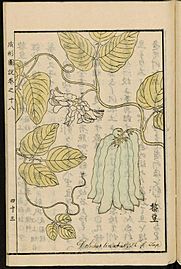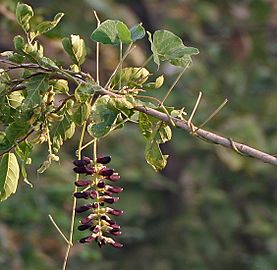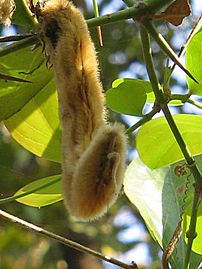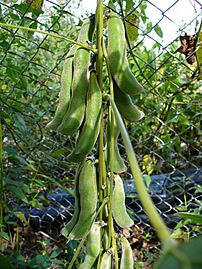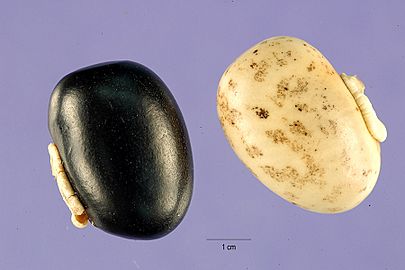Mucuna pruriens facts for kids
Mucuna pruriens is a cool plant that grows in warm, tropical places like Africa and tropical Asia. It's also known by many fun names like velvet bean or monkey tamarind. This plant is famous for making you super itchy if you touch its young leaves or seed pods! But it's also very useful for farming and in some traditional medicines.
Quick facts for kids Mucuna pruriens |
|
|---|---|
 |
|
| Mucuna pruriens inflorescence | |
| Scientific classification | |
| Genus: |
Mucuna
|
| Species: |
pruriens
|
| Synonyms | |
|
|
Contents
What Mucuna Pruriens Looks Like
Mucuna pruriens is a plant that grows like a vine. Its long vines can reach over 15 meters (about 50 feet) in length. When the plant is young, it has many soft, fuzzy hairs. As it gets older, most of these hairs disappear.
Leaves, Flowers, and Fruits
The leaves of the plant are made of three smaller leaflets. These leaflets can be oval, heart-shaped, or diamond-shaped. The edges of the leaves often have deep grooves, and their tips are pointy.
The flowers grow in groups called panicles. They can be white, lavender, or purple. Each flower group can be up to 32 centimeters (about 12.5 inches) long.
When the plant produces fruit, it forms a pod that is 4 to 13 centimeters (about 1.5 to 5 inches) long. This pod is covered in loose, orange hairs. These hairs are what cause a very bad itch if they touch your skin! Inside the pods, you can find up to seven seeds. These seeds are shiny black or brown and look like flattened oval shapes.
Why Mucuna Pruriens Makes You Itch
The hairs on the seed pods of Mucuna pruriens contain special chemicals. These include serotonin and a protein called mucunain. When these hairs touch your skin, they cause a very strong itching feeling.
If you scratch the itchy area, the hairs can spread to other parts of your body. It's very important not to touch your eyes if you've touched the plant, as it could cause temporary blindness. Because of how itchy it makes you, people in some places call the beans "mad beans" or "Devil Beans."
How People Use Mucuna Pruriens
Mucuna pruriens is a very useful plant around the world.
For Farming and Soil
- Animal Feed: Farmers feed the whole plant to animals as hay or dried seeds. It's a good source of protein for them.
- Soil Health: This plant is a legume, which means it can take nitrogen from the air and put it into the soil. This helps to make the soil healthier and more fertile for other plants.
- Controlling Weeds: In some countries like Benin and Vietnam, it's used to help control a problematic grass called Imperata cylindrica.
As Food
In Indonesia, especially on the island of Java, the beans are eaten. They are known as 'Benguk'. People can also ferment the beans to make a food similar to tempeh, called 'tempe Benguk'.
In Traditional Medicine
For a long time, people in tribal communities have used this plant to help with snakebites. Scientists have also studied its effects against bites from different types of snakes, like cobras and vipers.
The plant's seeds contain a chemical called L-DOPA. Because of this, it has been looked at as a possible treatment for Parkinson's disease. The seeds may help protect brain cells in people with this condition.
See also
 In Spanish: Grano de terciopelo para niños
In Spanish: Grano de terciopelo para niños


